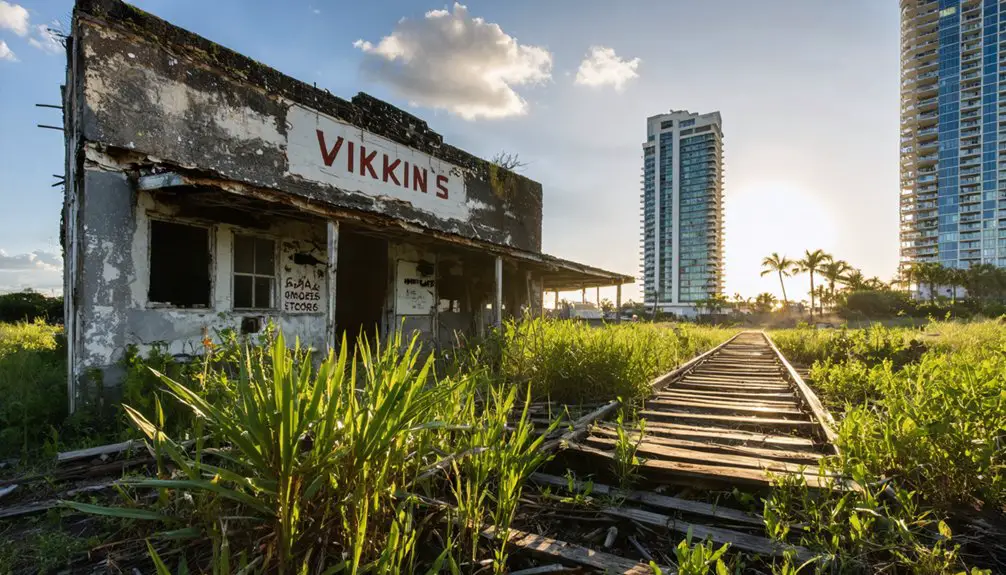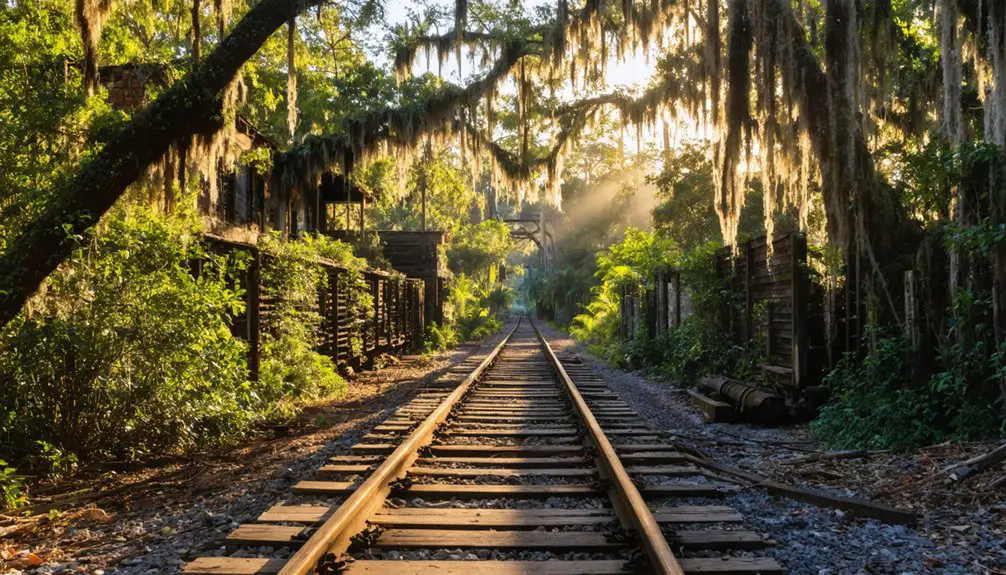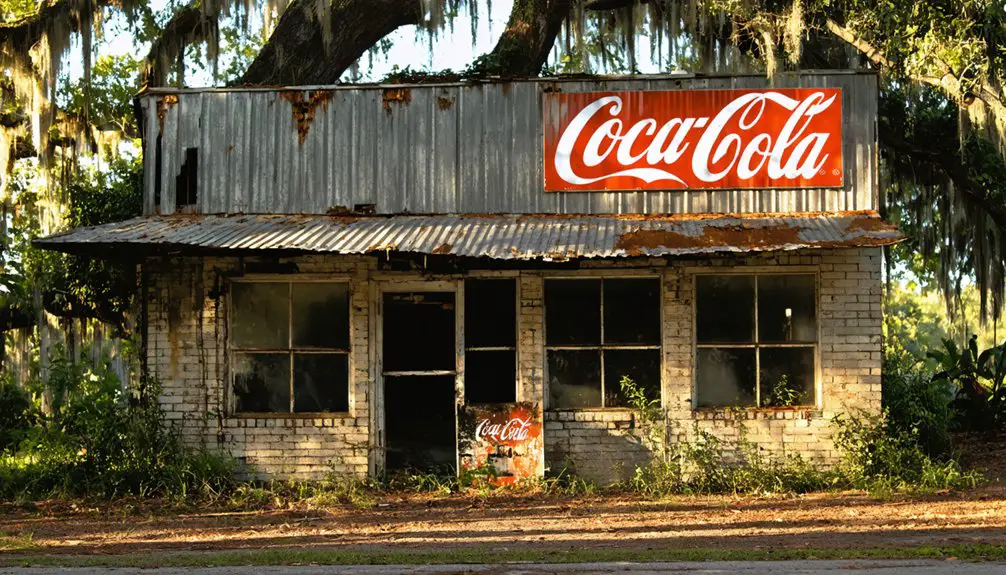You’ll discover Viking, Florida as a fascinating ghost town founded by Scandinavian settlers in 1892. Led by Major B. Daniels and the Helseth family, this pineapple farming community flourished along the Florida East Coast Railroad, growing from 30 to 300 residents during its peak years. While modern development has replaced most of the original farmland, the historic Viking Cemetery, established in 1905, stands as the last physical reminder of this unique cultural settlement’s remarkable story.
Key Takeaways
- Viking was established in 1892 by Scandinavian settlers in Florida, primarily focusing on pineapple cultivation and agricultural development.
- The settlement grew from 30 to 300 residents during its peak, with a post office and Florida East Coast Railroad flag stop.
- Named for its significant Scandinavian population, Viking developed into a close-knit farming community with essential services and infrastructure.
- The Viking Cemetery, established in 1905, remains the last physical remnant of the ghost town with 59 grave markers.
- The town declined as transportation evolved beyond railway flag stops, but its legacy continues through preservation efforts and historical documentation.
In 1892, a distinctive community took root in Florida when Scandinavian settlers established the town of Viking, drawn by the region’s potential for pineapple cultivation.
As you explore this unique chapter in Florida’s history, you’ll find that these pioneering families brought their Scandinavian heritage to the sunshine state, creating a close-knit community centered around agriculture.
The settlers quickly transformed the landscape into thriving pineapple farms, marking the beginning of Viking’s agricultural legacy.
The development of Viking was greatly influenced by Major B. Daniels, who became one of the first settlers of this Florida community.
You can trace how their determination and farming expertise helped establish a flourishing settlement, complete with a post office and school.
Jens Helseth contributed significantly to Viking’s growth by establishing his own pineapple plantation in the area.
While other ethnic groups eventually joined the community, the strong Scandinavian influence remained evident in the town’s name and cultural practices, shaping Viking’s identity for generations to come.
Pineapple Pioneers: Major B. Daniels and the Helseths
Two pioneering families laid the agricultural foundation for Viking’s success in the 1890s. Major B. Daniels first settled the wilderness in 1892, establishing a thriving pineapple plantation that would attract future settlers. Major B. Daniels would live a long life, reaching age eighty-seven before his death in 1947.
Three years later, Norwegian immigrants Jens and Agathe Helseth arrived, expanding pineapple cultivation across their 80-acre farm. The settlement was renamed Viking due to its growing Scandinavian population.
Their combined achievements included:
- Transforming untamed Florida wilderness into productive agricultural land
- Creating a hub for pineapple cultivation that drew other Scandinavian settlers
- Establishing lasting community landmarks, with Daniels’ legacy marked by his final resting place in Viking Cemetery, and the Helseths’ contribution of land for the community burial ground in 1905
These immigrant contributions shaped Viking’s identity and agricultural prosperity for generations to come.
Early Infrastructure and Community Development
You’ll find Viking’s early infrastructure centered around essential community services, including a post office that connected residents to the outside world and served as a gathering spot.
The Florida East Coast Railroad‘s flag stop in Viking proved vital for both passenger travel and shipping the town’s pineapple harvests to distant markets. Similar to old dirt roads found in other ghost towns, Viking’s transportation network facilitated movement between community areas.
The combination of postal services and rail access helped transform Viking from scattered homesteads into a more cohesive settlement where residents could meet, conduct business, and build community bonds. Like many Florida towns established during the early 1900s land boom, Viking’s development was driven by the era’s rapid expansion and settlement.
Post Office Operations
As Viking established itself in the late 19th century, the town’s post office emerged as an essential communication hub that helped bind the growing settlement together.
Similar to the town of Acron, Viking saw its community grow from 30 to 300 residents during its peak years of development.
The post office’s significance extended far beyond mail delivery, serving as a crucial community hub where residents could:
- Exchange news and information critical for maintaining local commerce and social connections
- Receive goods and correspondence that sustained Viking’s agricultural economy
- Maintain cultural ties, especially important for the area’s Scandinavian settlers
You’ll find the post office operated from a simple, functional building typical of rural Florida, featuring mail slots and boxes accessible by keys. In 2005, the historic structure was moved to Adams Ranch before being donated back to the community.
Under the leadership of postmasters like John C. Campbell, it served as tangible proof of Viking’s formal recognition by the U.S. postal system, reinforcing the town’s status and potential for growth.
Railroad Flag Stop
The Florida East Coast Railroad’s flag stop at Viking played a pivotal role in the town’s early development, connecting this rural settlement to the wider region.
As you explore Viking’s railroad history, you’ll find that this transportation link was vital for the community’s growth, allowing settlers to move goods and people efficiently through the area. Like many Florida railways of the era, labor shortages initially challenged construction efforts. Like other stops along the railway developed by Henry Flagler’s vision, this location became part of Florida’s expanding transportation network.
The flag stop significance went beyond mere convenience – it represented Viking’s lifeline to surrounding communities and markets.
While not a major station, the flag stop system meant trains would pause when signaled, supporting the town’s pineapple plantation operations and helping Major B. Daniels and other settlers establish their agricultural ventures.
This railroad connection proved essential for Viking’s early economic success, though today little remains of this once-vital transportation hub.
Community Meeting Places
While Viking’s early settlers focused on building a cohesive community, several key meeting places emerged as essential hubs for social interaction and civic life.
You’ll find that these gathering spots played significant roles in maintaining social bonds and preserving cultural traditions among the town’s Scandinavian residents.
The community’s central meeting places included:
- The local school, which served beyond its educational role as a venue for community gatherings and events
- The cemetery, established on Hellseth’s homestead, which became a permanent landmark for ceremonies and remembrance
- The small stores and commercial spaces that provided informal social hubs where residents could connect while conducting daily business
These multi-purpose venues fostered the tight-knit relationships that were important to Viking’s pioneer spirit, reflecting the practical approach of early Florida settlements.
Life Along the Florida East Coast Railroad

If you’d traveled through Viking in the early 1900s, you would’ve encountered a bustling flag stop where the Florida East Coast Railroad halted to load agricultural products and lumber bound for northern markets.
The station’s presence made Viking a crucial link in the region’s economic chain, connecting local farmers and timber operations to Jacksonville’s larger commercial networks.
Your visit would’ve revealed a town dependent on the railroad’s regular stops, where the loading platform served as both a commerce hub and informal gathering place for residents awaiting shipments or news from other communities along the line.
Railroad Commerce and Growth
During Florida’s rapid expansion in the late 19th century, Henry Flagler’s Florida East Coast Railway transformed the state’s eastern corridor into a vibrant hub of commerce and growth.
The railroad expansion’s economic impact reached far beyond the tracks themselves, revolutionizing how communities like Viking conducted business and connected with the world.
You’ll find the railway’s influence manifested in three key ways:
- Agricultural development flourished as farmers gained direct access to northern markets, shipping citrus and vegetables with unprecedented speed.
- Tourism boomed through Flagler’s strategic placement of luxury hotels and amenities along the route.
- Small settlements transformed into trading centers as station locations became natural gathering points for commerce, fostering the growth of local businesses and industries.
Flag Stop Town Legacy
As trains rumbled through Florida’s eastern corridor, Viking emerged as one of many flag stop towns dotting the Florida East Coast Railway‘s route.
You’d have witnessed a simple yet essential system where residents signaled passing trains to stop, transforming isolated rural spots into connected communities.
The flag stop significance extended beyond mere transportation – it created lifelines for small-scale farmers and settlers who’d otherwise remain cut off from broader markets.
Despite minimal infrastructure, these communities showed remarkable resilience, adapting their daily routines to train schedules and seasonal agricultural cycles.
While many flag stops, including Viking, eventually faded as transportation evolved, they’ve left an indelible mark on Florida’s railway heritage, representing an era when a simple railroad flag could bridge the gap between isolation and opportunity.
The Legacy of Viking Cemetery
Established in 1905 by Norwegian immigrant Jens Helseth, Viking Cemetery stands as one of the last tangible remnants of Florida’s vanished Scandinavian settlement.
You’ll find profound cemetery significance in its 59 grave markers, which chronicle the area’s transformation from pineapple farmland to modern development.
The cemetery’s heritage preservation efforts highlight three key aspects:
- Archaeological documentation by FLHCRP and FPAN guarantees the site’s historical record
- Continued maintenance by Helseth’s great-great grandchildren preserves family connections
- Protected status safeguards this cultural monument for future generations
Today, while the original Viking townsite has largely disappeared beneath modern growth, this historic burial ground continues to tell the story of Florida’s brave Norwegian pioneers and their enduring legacy along the east coast.
From Farmland to Modern Development

When Norwegian settlers first arrived in Viking during the late 19th century, they transformed untamed Florida wilderness into thriving pineapple farms. This Viking heritage flourished as the community grew around its agricultural roots, establishing homesteads and essential amenities along the Florida East Coast Railroad.
You’ll find that Viking’s agricultural decline began with devastating freezes, including the Big Freeze of 1894-1895, followed by economic hardships and natural disasters that forced many farmers to abandon their land.
As the 20th century progressed, the town’s farmland gave way to modern development. Today, the original townsite has largely disappeared beneath Fort Pierce’s expanding neighborhoods and commercial zones.
While contemporary structures now cover Viking’s historic landscape, the Viking Cemetery stands as the last physical reminder of this once-vibrant farming community.
Notable Figures Who Shaped Viking
The pioneers who shaped Viking’s early development were led by Norwegian immigrants Jens and Agathe Helseth, who founded the settlement in 1895 with their expansive pineapple farm. Their commitment to cultural preservation and agricultural heritage established Viking’s identity as a Scandinavian enclave in Florida.
Three key figures left lasting impacts on Viking’s development:
Viking’s remarkable evolution was shaped by three pivotal pioneers whose leadership and vision created lasting foundations for the community.
- Major B. Daniels initiated pineapple cultivation in 1892, laying the economic foundation.
- Bob Lennard emerged as Saint Lucie County’s first sheriff, establishing law and order.
- Jens Helseth donated land for Viking Cemetery in 1905, creating a permanent memorial site.
These early settlers’ influence extends beyond their time, with Helseth’s legacy visible in surviving lamp posts and the cemetery where generations of Viking’s founding families rest.
The Economic Rise and Fall

You’ll find Viking’s economic story dominated by its pineapple industry, which flourished under Scandinavian settlers like Major B. Daniels and the Helseths in the 1890s.
The Florida East Coast Railroad‘s flag stop at Viking proved essential for the town’s agricultural exports, allowing farms to ship their produce efficiently and sustain the local economy.
As the 20th century progressed, Viking’s farmlands gave way to residential development and nature preserves, marking the end of its agricultural era and its eventual dissolution as a distinct town.
Pineapple Industry Dominance
During the late 19th century, Viking’s transformation into a thriving agricultural center began with Major B. Daniels and Jens Helseth pioneering pineapple cultivation in the area.
The region’s sandy soils and subtropical climate proved ideal for growing these prized fruits, leading to rapid industry expansion.
You’ll find that Viking’s success in pineapple farming was marked by:
- Development of advanced agricultural techniques that maximized yields and fruit quality
- Establishment of essential infrastructure, including a railroad flag stop for efficient transport
- Formation of a strong Scandinavian farming community that shared expertise
Modern Development Takes Over
While Viking’s pineapple industry once defined its economic significance, modern development gradually altered the agricultural landscape into a maze of residential streets and commercial establishments.
You’ll find little evidence of the town’s agricultural roots today, as urban expansion has systematically replaced former farmland with suburban infrastructure.
The town’s historic features – including schools, a post office, and the railroad flag stop – have largely disappeared beneath modern construction.
This push toward development reflects Florida’s broader evolution from rural to suburban landscapes, where historical preservation often takes a back seat to commercial interests.
The original Scandinavian homesteads and farming operations that once characterized Viking have given way to contemporary housing and retail spaces, leaving only the cemetery as a tangible reminder of the community’s past.
Viking’s Geographic Evolution
As Viking emerged in the late 1800s, its geographic footprint evolved from scattered homesteads into a structured community anchored by Scandinavian settlers.
The settlement patterns reflected a shift from agricultural roots to a more complex town layout, while community dynamics centered around shared infrastructure.
You’ll find Viking’s geographic evolution marked by three distinct phases:
- Initial pineapple farms and homesteads defined the landscape
- Development of essential infrastructure including a post office, bakery, and sawmill
- Transformation into a railroad flag stop with commercial establishments
The town’s location within modern-day Fort Pierce shaped its destiny, as farmland gradually gave way to streets and buildings.
While most physical traces have vanished, the cemetery stands as an indication of Viking’s geographic legacy.
Preserving the Ghost Town’s Memory
Since Viking’s decline in the early 20th century, preservation efforts have focused on documenting and protecting the ghost town‘s remaining legacy.
You’ll find that memory preservation initiatives include researching historical records, collecting oral histories, and protecting physical remnants like the cemetery from decay and vandalism.
Community involvement plays a crucial role, with descendants of Viking’s original settlers contributing family stories and artifacts to enrich the historical narrative.
While Florida’s historic preservation movement started relatively late, growing interest in ghost town tourism has sparked new efforts to safeguard Viking’s heritage.
Through digital archives, educational programs, and public history projects, you can now access Viking’s story through various platforms, ensuring that this piece of Florida’s past won’t fade into obscurity like the town itself.
Frequently Asked Questions
What Did Viking Residents Do for Entertainment and Social Gatherings?
Like bees to a hive, you’d gather at the schoolhouse, church, and post office for community events, enjoying storytelling, music, hunting, fishing, and local pastimes during farming celebrations.
Were There Any Major Natural Disasters That Affected Viking’s Development?
While you won’t find specific records of major hurricanes or flooding directly hitting Viking, the devastating Great Freeze of 1894-1895 severely impacted the area’s pineapple plantations, contributing to the town’s eventual decline.
What Was the Highest Population Viking Ever Reached?
Through Viking’s history from its misty pineapple fields to declining streets, you won’t find an exact peak population documented. While the town supported a school and post office, precise numbers weren’t recorded.
Did Viking Have Any Churches or Religious Institutions?
You won’t find evidence of formal Viking churches or religious institutions. While settlers likely held religious gatherings, historical records only confirm a community cemetery donated by local homesteader Hellseth for burials.
How Did Residents Handle Medical Care and Emergencies in Viking?
You’d have relied on home remedies, traveling doctors, and neighbors for basic medical resources. During emergencies, you’d transport patients by wagon to larger towns or flag down trains for urgent care.
References
- https://www.youtube.com/watch?v=TxBONhwNi1k
- https://www.ghosttowns.com/states/fl/viking.html
- https://patchproflorida.com/blog/the-fascinating-history-of-floridas-ghost-towns/
- https://floridatrailblazer.com/category/ghost-towns/page/2/
- https://www.tiktok.com/@socialshepherdadventures/video/7342301852702100778
- https://richesmi.cah.ucf.edu/omeka/collections/show/178
- https://www.britannica.com/topic/Viking-people
- https://www.worldhistory.org/article/1880/the-norse-in-america-fact-and-fiction/
- https://riches.cah.ucf.edu/?p=1683
- https://richesmi.cah.ucf.edu/omeka/items/show/7329



